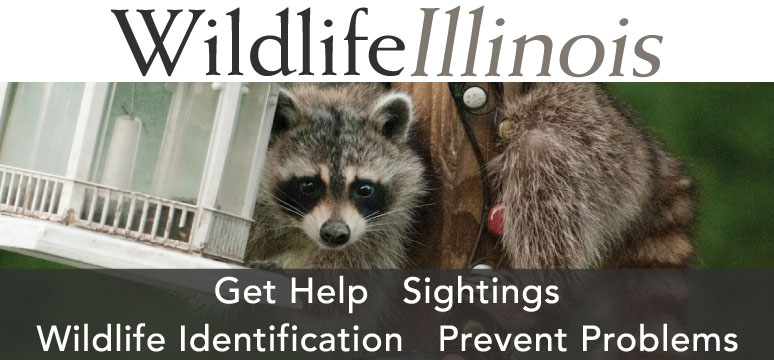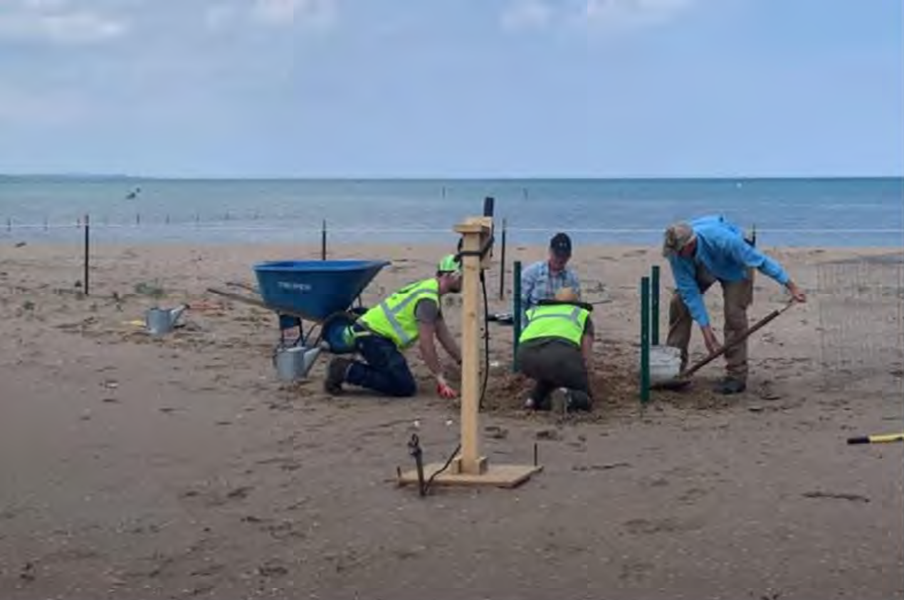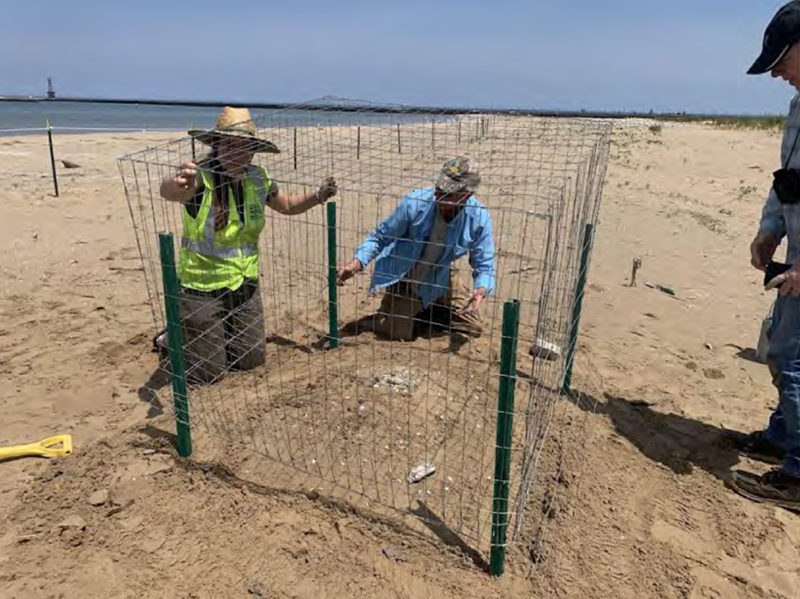
Photo by Dan Kirk




Photo by Dan Kirk
Blue skies turned gray and then dark as the storm rolled over the Chicago skyline and hit Montrose Beach, dropping heavy rains in its wake. On June 1, 2024, standing water started to accumulate in the lower areas of the beach, and the monitors of the endangered piping plovers were watching closely. The nest cup of Imani and Searocket was located on a small rise of sand only a few inches above the surrounding sand flat.

Undeterred by the weather, one of the adults remained on the nest cup throughout the intense storm and the rising water. The first egg had been laid two days prior on May 30, and the second had been laid earlier that morning. Two more eggs would be laid before the clutch was complete, but it was becoming increasingly uncertain if the nest cup would survive the storm. At 8:25 p.m. the sitting adult left the nest and neither Imani nor Searocket had returned when the nest monitors finally left the beach at 11 p.m.
At this point in the story, Brad Semel, Illinois Department of Natural Resources Regional Recovery Specialist, had me completely hooked. I breathed a little easier after learning that he’d captured an image of one of the adults back on the nest at 2:30 a.m. on June 2. At sunrise the following morning, when the monitors arrived at the beach, all the water from the storm had dissipated into the sand, but there was still concern for the nest.

The plover monitors and the city, state and federal agency biologists who were there to help protect the nest were all too aware of the precarious situation the nest was in and were intimately familiar with what lakeshore flooding can do to plover nests.
Indeed, the clutch of eggs that the famous Chicago pair of piping plovers Monty and Rose had laid on this very same beach in early June of 2019 was in a similar location: an area of low elevation on the beach that was prone to flooding during big storm events. That year a storm hit the beach during the night of June 12. It brought with it heavy lake swells and intense rain and the nest was totally flooded. That nest was abandoned by the birds and valiant efforts were taken at the Lincoln Park Zoo and then at the University of Michigan Biological Station in Pellston, MI, to incubate the clutch. Ultimately, none of the four eggs hatched.

Given that the Great Lakes population of piping plovers is listed as both federally and Illinois endangered, I knew that they have special protections above and beyond those afforded to other wild birds in the state. So, I asked Semel what, if anything, could be done to protect the eggs and nest?
Semel said, “Given the storm predictions, the nest location, and the fate of a previous clutch under similar conditions, we felt the best approach was to raise the nest and reinforce the base. We went into the dunes where the Montrose pair had made several other scrapes prior to selecting the current nest site. The team explored how the nest scrape might be manipulated. After some preliminary trials, agency staff felt that the fragile nest cup could be protected if done with extreme care.”

You might be wondering why so much care was taken to support this particular nest? Imani and Searocket’s nest was especially important, not just because piping plovers are an endangered species in Illinois, but also because their nest was the first piping plover nest at Montrose since 2021. And their nest was also one of only two nests in the entire state of Illinois at the time.
Additionally, piping plovers are more likely to return to a site if they have a successful nesting attempt. All of these reasons added up to explain why all the piping plover partners were eager to do everything they could within legal standing to keep the nest in the wild.

The plover pair showed increased activity following the rain event and it was anticipated that a third egg would be laid on June 3, just as the next storm event was predicted to arrive. The biologists shared their plan with the Great Lakes Piping Plover Conservation Team and discussed at length the alternatives they had available. Then they requested approval from the U.S. Fish and Wildlife Service and the work was conducted under proper State and Federal permitting.
With formal approvals in place, in the early morning hours of June 3 the plover team returned to Montrose Beach to undertake the planned raising of the nest. Semel noted that they practiced several times before alterations at Imani and Searocket’s nest were made. Each member of the team was assigned unique responsibilities.
“Upon arrival at the nest we quickly disassembled the exclosure cage and removed it for access to the nest. After relocating the cage wire, the eggs were protected and out of harm’s way,” said Semel.

The new base height was established, and careful attention was made to pack the sand around the original nest cup and to minimize the slope of the rise in case it would influence the birds’ acceptance of the modification. When the work was complete, the exclosure cage was put back into place over the corner posts.
The plovers wasted no time checking on the nest and their eggs. Imani returned a mere 46 seconds after the last person left the nesting area. Searocket returned just a few minutes later and they did a nest exchange.
Unfortunately, the fine sand grains used in reinforcing the nest site were exposed to a prolonged and very impactful storm event over the course of three consecutive days, with winds on the exposed beach at times topping 65 mph. Agency personnel again began to discuss options as the exposed west side of the base started to erode. At first, they tried to add some water at the nest in hopes that the moisture would help hold the fine sand particles in place. However, by conclusion of the storm event, the original nest cup was critically threatened with collapse.

The team decided the time was critical to make additional modifications. A protective bucket was placed around the nest cup and sand added to the base of the nest. The most important modification was adding a clay/silt mix obtained from nearby excavation in the panne swale. This mix turned out to be far more resistant to erosion than the fine sand found at the nest site. Sandbags were filled and stockpiled near the nest should another extreme storm event occur—one with more significant beachfront erosion and waves overtopping the foredune.
Semel explained, “Since reinforcing the nest, at least three storm events occurred within the week that would have flooded the original nest and eggs.” Unbeknownst to the team, the worst was yet to come.

In the early morning hours of June 25, a strong storm front approached the Montrose nest site. Unlike previous storms that had approached from the west, Semel explained that this line of strong thunderstorms approached directly from the north and traveled over the entirety of the 321 miles of the open waters of Lake Michigan. And at 6:15 a.m. a meteotsunami hit the shoreline.
Unlike tsunamis that typically are triggered by seismic activity, meteotsunamis are driven by air-pressure disturbances associated with fast-moving weather events, such as severe thunderstorms, squalls and other storm fronts. They are commonly known as a “seiche.” The June 25 storm generated a single 2- to 3-foot wave that ravaged the entire beachfront. The wave raced around and past the fortified nest. The incubating bird never left the nest!
The meteotsunami generated wave line extended well past the nest and into the dunes. But within 8 minutes following the meteotsunami hitting the shore, the waters had started to recede from around the raised nest. Eight long minutes for the nest occupants— and the monitors who witnessed the event!

Within 2 hours of the storm’s passing, conditions improved, and the plovers made another nest exchange. With the impact of the wave clearly visible across the entire beachfront, agency personnel knew that some nest repairs would be needed. They approached the nest and spent nine rushed minutes adding sand to the base. Using a modified hoe, they pulled sand back up around the nest cup where the intense rain had washed away the sand and formed a small gully.
As Semel concluded this fascinating story, he shared that “this time both birds remained at the nest site, and we had to use care to avoid placing sand on the birds while shoveling. Imani returned to the nest and settled down on the clutch of four eggs while we were departing.”
Determination and innovation prevailed. Three tiny chicks successfully hatched on June 29 and the fourth chick hatched the following day. Despite surviving the significant impacts from the storms, three of the chicks did not make it to adulthood: three of them died from unknown causes in mid-July. Searocket and Imani’s surviving chick, Nagamo, was watched closely for the rest of the summer and left for his/her winter grounds in September 2024.

The sex of a piping plover chick can’t be visually determined until after their first pre-alternate molt, which happens in March or April following their hatch year. During this molt they change to their breeding plumage which allows them to be identified as an adult male or female plover. Hopefully Nagamo will safely return to Montrose Beach this spring.
The return of Nagamo would not be the only success story from the 2024 nesting season. The efforts to save Imani and Searocket’s nest provided another successful proof of concept. This innovative approach was first piloted in Pennsylvania in 2023, where it saved another plover nest.

Although this story focuses on the fate of a single nest made by two rare plovers, it highlights the importance of the Chicago Piping Plover monitors and the strong partnership that has been formed among the Chicago Park District, the Illinois Department of Natural Resources, U.S. Department of Agriculture APHIS, U.S. Fish and Wildlife Service and the Great Lakes Piping Plover recovery team. The area of roughly 16 acres of sand and beach known as Montrose Dunes Natural Area in Lincoln Park, Chicago is vital habitat for the piping plovers. This area is one part of a compelling story of conservation and local efforts to protect piping plovers and the lakefront habitat critical for the plovers and an extensive number of other migrating and nesting avian species.
Brad Semel is the Endangered Species Recovery Specialist for the Illinois Department of Natural Resources, leading statewide conservation efforts for state and federally listed species. He is responsible for coordinating academics and professionals within state and federal agencies to develop adaptive resource management guidelines and novel approaches and techniques for the conservation of rare species and provide oversight and training to professionals in specialized areas of statewide recovery efforts.
Laura Kammin is a Natural Resources Specialist with the National Great Rivers Research and Education Center. She formerly held positions at Illinois-Indiana Sea Grant, University of Illinois Extension, Prairie Rivers Network and the Illinois Natural History Survey. She received her master’s degree in wildlife ecology from the University of Illinois, Urbana-Champaign.
Submit a question for the author